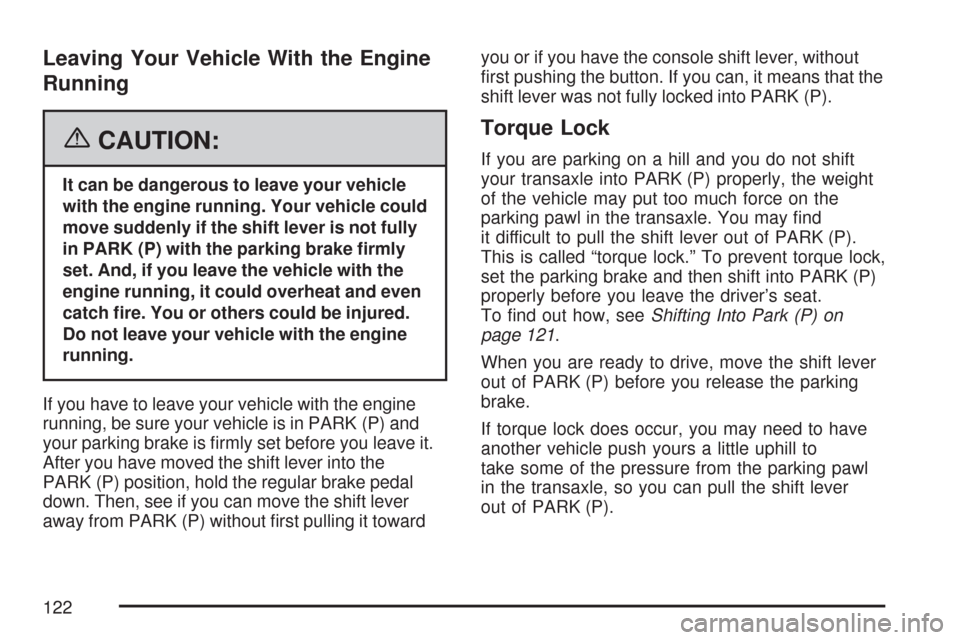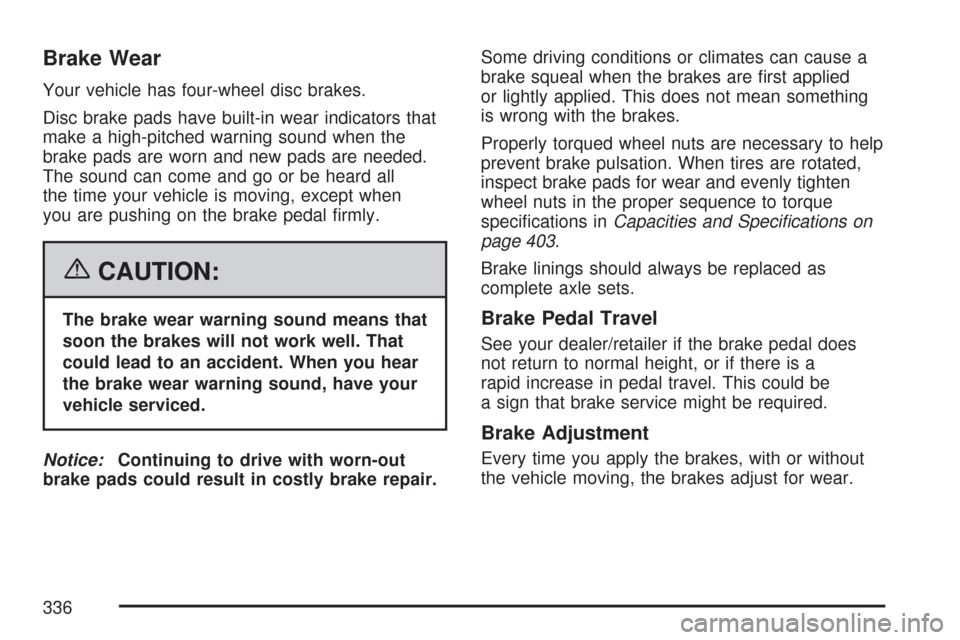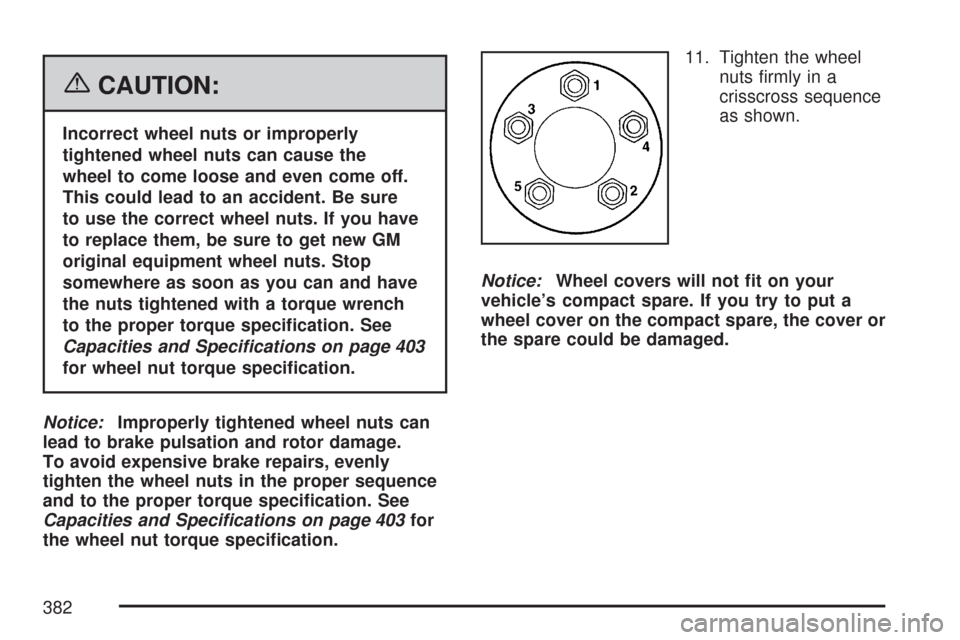Page 122 of 460

Leaving Your Vehicle With the Engine
Running
{CAUTION:
It can be dangerous to leave your vehicle
with the engine running. Your vehicle could
move suddenly if the shift lever is not fully
in PARK (P) with the parking brake �rmly
set. And, if you leave the vehicle with the
engine running, it could overheat and even
catch �re. You or others could be injured.
Do not leave your vehicle with the engine
running.
If you have to leave your vehicle with the engine
running, be sure your vehicle is in PARK (P) and
your parking brake is �rmly set before you leave it.
After you have moved the shift lever into the
PARK (P) position, hold the regular brake pedal
down. Then, see if you can move the shift lever
away from PARK (P) without �rst pulling it towardyou or if you have the console shift lever, without
�rst pushing the button. If you can, it means that the
shift lever was not fully locked into PARK (P).
Torque Lock
If you are parking on a hill and you do not shift
your transaxle into PARK (P) properly, the weight
of the vehicle may put too much force on the
parking pawl in the transaxle. You may �nd
it difficult to pull the shift lever out of PARK (P).
This is called “torque lock.” To prevent torque lock,
set the parking brake and then shift into PARK (P)
properly before you leave the driver’s seat.
To �nd out how, seeShifting Into Park (P) on
page 121.
When you are ready to drive, move the shift lever
out of PARK (P) before you release the parking
brake.
If torque lock does occur, you may need to have
another vehicle push yours a little uphill to
take some of the pressure from the parking pawl
in the transaxle, so you can pull the shift lever
out of PARK (P).
122
Page 336 of 460

Brake Wear
Your vehicle has four-wheel disc brakes.
Disc brake pads have built-in wear indicators that
make a high-pitched warning sound when the
brake pads are worn and new pads are needed.
The sound can come and go or be heard all
the time your vehicle is moving, except when
you are pushing on the brake pedal �rmly.
{CAUTION:
The brake wear warning sound means that
soon the brakes will not work well. That
could lead to an accident. When you hear
the brake wear warning sound, have your
vehicle serviced.
Notice:Continuing to drive with worn-out
brake pads could result in costly brake repair.Some driving conditions or climates can cause a
brake squeal when the brakes are �rst applied
or lightly applied. This does not mean something
is wrong with the brakes.
Properly torqued wheel nuts are necessary to help
prevent brake pulsation. When tires are rotated,
inspect brake pads for wear and evenly tighten
wheel nuts in the proper sequence to torque
speci�cations inCapacities and Speci�cations on
page 403.
Brake linings should always be replaced as
complete axle sets.Brake Pedal Travel
See your dealer/retailer if the brake pedal does
not return to normal height, or if there is a
rapid increase in pedal travel. This could be
a sign that brake service might be required.
Brake Adjustment
Every time you apply the brakes, with or without
the vehicle moving, the brakes adjust for wear.
336
Page 365 of 460

When rotating your tires, always use the correct
rotation pattern shown here.
Do not include the compact spare tire in your
tire rotation.
After the tires have been rotated, adjust the front
and rear in�ation pressures as shown on the Tire
and Loading Information label. SeeIn�ation - Tire
Pressure on page 359andLoading Your Vehicle on
page 277.Reset the Tire Pressure Monitor System. See
“TPMS Sensor Identi�cation Codes” under
Tire Pressure Monitor System on page 360.
Make certain that all wheel nuts are properly
tightened. See “Wheel Nut Torque” under
Capacities and Speci�cations on page 403.
{CAUTION:
Rust or dirt on a wheel, or on the parts to
which it is fastened, can make wheel nuts
become loose after time. The wheel could
come off and cause an accident. When
you change a wheel, remove any rust or
dirt from places where the wheel attaches
to the vehicle. In an emergency, you can
use a cloth or a paper towel to do this;
but be sure to use a scraper or wire brush
later, if needed, to get all the rust or dirt
off. SeeChanging a Flat Tire on page 374.
365
Page 382 of 460

{CAUTION:
Incorrect wheel nuts or improperly
tightened wheel nuts can cause the
wheel to come loose and even come off.
This could lead to an accident. Be sure
to use the correct wheel nuts. If you have
to replace them, be sure to get new GM
original equipment wheel nuts. Stop
somewhere as soon as you can and have
the nuts tightened with a torque wrench
to the proper torque speci�cation. See
Capacities and Specifications on page 403
for wheel nut torque speci�cation.
Notice:Improperly tightened wheel nuts can
lead to brake pulsation and rotor damage.
To avoid expensive brake repairs, evenly
tighten the wheel nuts in the proper sequence
and to the proper torque speci�cation. See
Capacities and Specifications on page 403for
the wheel nut torque speci�cation.11. Tighten the wheel
nuts �rmly in a
crisscross sequence
as shown.
Notice:Wheel covers will not �t on your
vehicle’s compact spare. If you try to put a
wheel cover on the compact spare, the cover or
the spare could be damaged.
382
Page 404 of 460
ApplicationCapacities
English Metric
Fuel Tank
3.5L Engine (with NU6 emissions) sold new in CA, ME,
VT, NY, MA (see your dealer for bordering states)17.0 gal 64.4 L
3.5L Engine (without NU6 emissions) sold new in all other
states (see your dealer for more information)17.5 gal 66.2 L
3.9L and 5.3L Engines sold in all states 17.5 gal 66.2 L
Wheel Nut Torque 100 lb ft 140 Nm
All capacities are approximate. When adding, be sure to �ll to the approximate level, as recommended in this
manual. Recheck �uid level after �lling.
Engine Speci�cations
Engine VIN Code Transaxle Spark Plug Gap
3.5L V6 N Automatic 0.040 inches (1.01 mm)
3.5L Flexible Fuel V6 K Automatic 0.040 inches (1.01 mm)
3.9L V6 with Active Fuel
Management™R Automatic 0.040 inches (1.01 mm)
5.3L V8 C Automatic 0.040 inches (1.01 mm)
404